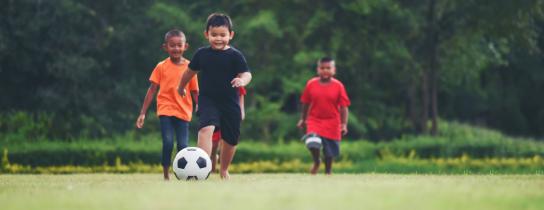
How To Keep Kids Safe When Playing Sports: A Message from Crystal Run’s Haverstraw Pediatricians
In recent years, more children are participating in competitive sports. Playing team sports provides a great opportunity for youth to stay healthy and fit, work as a team, develop lasting friendships and gain a sense of pride and satisfaction. However, this increased participation has led to an increase in sports injuries, which often can be attributed to failure to comply with some common routine prevention strategies. It is our responsibility as doctors, parents and coaches to help our children play the sports they love safely.
When engaging in sports, there are important risk reduction strategies that need to be in place to minimize risk and maximize safety.
Team preparation
All children should be seen by their pediatrician for a sports clearance participation exam or ‘sports physical’ prior to the start of the sports season. It is important to disclose to the pediatrician any current medical conditions your child may have, such as asthma as well as any family history of heart disease or cardiac risk factors. It is better to delay the start of a season than to potentially become the victim of a preventable tragedy. Coaches should review all physicals to be aware of any pertinent medical history or physical findings.
Proper Equipment
Child athletes should be properly fitted with all necessary sports equipment prior to playing the sport. Equipment should be tailored to the sport; a child playing baseball will need different equipment than a child playing football. Helmets are required for several different sports including football, baseball, and lacrosse. For baseball, batting helmets should be worn when a child is at bat, waiting to bat and running the bases. Protective gear such as shin guards, mouth guards, goggles, shoulder or thigh pads, and chest protectors should be worn when required. Children who need glasses should wear the appropriate sports glasses with non-shattering glass to prevent injury. Proper shoes or cleats should be provided as well, and all equipment should be approved athletic equipment.
Recently, several aluminum bats have been declared unsafe by children’s little league organizations. All equipment should be for the appropriate age and size of the athlete using it and should be in good condition. While using hand-me downs or borrowing equipment from older players may save money, it can be dangerous if the gear doesn’t fit the child properly.
Stretching Exercises
Pre-sport exercises help properly condition the body to increase flexibility and strengthen muscles. Jogging at the beginning of practice or prior to a game is a great way to help loosen muscles. Neglecting to warm up prior to participation can lead to increased injuries including shin splints and stress factures.
Hydration
Proper hydration is the key for any sport to prevent dehydration and other heat-related illnesses. Athletes should come prepared to practice with water bottles and be encouraged to hydrate prior to beginning the sport. Routine water breaks should be taken every 20 minutes during both practice and games. The American Academy of Pediatrics (AAP) recommends drinking 4-8 ounces of water during each of these hydration breaks. Water is the preferred method of hydration over sports beverages. Higher level competitive athletes should weigh themselves pre-workout and post- 1 hour workout. They should drink 16-20 ounces of water per pound lost. To prevent the spread of germs, children should not share their water bottles with other players. Coaches should come prepared with extra water bottles in case someone forgets.
Heat-related concerns
Take adequate rest periods during times of high heat and humidity. If possible, avoid outdoor exercise between the hours of 11 am and 3 pm during the summer months when temperatures are at their highest. This will serve to reduce injuries and heat-related illnesses. Parents, coaches and players should be aware of the symptoms of heat exhaustion, including extreme drowsiness, headache, fever, nausea, vomiting or change in breathing, and act promptly if they or their player starts to show symptoms. A broad spectrum sunscreen with a minimum 15-30 SPF should be applied 15 minutes prior to exposure and reapplied every 2 hours.
Concussions
It is crucial that athletes wear the appropriate helmet for the sport they are participating in. Helmets can prevent serious head injuries, but do not prevent concussions. Any type of head injury needs immediate evaluation on the sidelines by a trained professional. For any suspected concussion, the athlete should be removed from the game until they receive an evaluation and clearance from their physician. A concussion is a brain injury caused by rapid movement of the head and brain caused by a direct or indirect blow.
Typical recovery for a concussion is one to three weeks and adolescents take longer to recover than school age children. A gradual step-wise approach to return to play is used as kids who suffer from a concussion are unable to return until they’re symptom-free and have gone back to school full time. If there is a recurrence of symptoms, the child must go back to the previous step to allow more time for healing. It is crucial that athletes do not play prior to being ready to prevent second impact syndrome which could lead to death. When it comes protecting children from potential head injuries, playing it safe and conservative is key.
Working with a child’s pediatrician and coach as a team will help ensure the safety of the young athlete so they could continue to play the sport and avoid unnecessary injuries.
As parents, it’s important to remember to follow the same safety guidelines as our children so that we can be good role models and lead by example. Never hesitate to reach out to your pediatrician or coach with your concerns, the life saved could be your own child’s!

 Optum Radiology at Crystal Run Healthcare
Optum Radiology at Crystal Run Healthcare Request medical records online
Request medical records online